 |
| [Saint Paul's skyway has it worse than Minneapolis, b/c it lacks DT density.] |
But the skyway system also throws a spotlight on how our cities always remain capital, private property in search of a profit. There is a common misconception about the skyway system where people seem to think that they’re neutral and altruistic, designed simply to keep people warm in the winter and dry in the rain.
Actually, skyways are all about increasing property values and maintaining control over private and public spaces. I wrote about this in a very wonky article for this blog way a few years ago, calling climate “a proxy for capital.” What that means is that the winter becomes a kind of facade for profit and property. The money quote (pardon the pun) is here, taken from a Geography dissertation all about the skyway system:
As one Minneapolis business owner put it, “if the public thinks they need protection from the weather let them. We’ll give them what they want as long as they keep spending money” (quoted in Byers 1998 160).In my earlier piece I compared the skyway to the Haussmannization of Paris in the 1870s, where the city became a space of contest and control aimed at creating spaces for the bourgeoning bourgeois. In other words, the city operated as a ground for class warfare.
 |
| [Calling for the end to skyways c. 1980.] |
Semi-Public Space and Race
 |
| [Policing the street is far worse in downtown L.A.] |
It is difficult truth to think through, forcing Minnesotans to confront race and class gap within the very spaces that make us proud. One potential casualty of the struggle for downtown is that it will no longer be a place where everyone feels welcome.
(For the state of downtown c. 2014, see Jim Walsh’s excellent and honest look at the diversity of downtown Minneapolis night life.)
For me, downtown is the only place where black and white, rich and poor, workers and clubbers, suburbanites and the homeless, tourists and locals might cross paths. Because the Twin Cities is so extremely socially and racially segregated, we need our downtown. What else is there?
 |
| [The 2012 Common Room "skyway tour" in the IDS Crystal Court.] |
 |
| [My skyway tour getting kicked out of the IDS Crystal Court in Minneapolis.] |
Improving the Skyways?
For the Minnpost piece I talked to tow people who have studied the skyway system over the years: Nancy Fischer, a professor of sociology at Augsburg College, and Jennifer Yoos, an architect for VJAA. They shared a few ideas for how to make the skyways more of a public place.
Yoos described the IDS center as the gold standard of how to design a good skyway. (That said, my skyway tour from a few years ago was kicked out of the “Crystal Court”, which closes around 8:00 or so.)
 |
| [Inside the Guthrie.] |
“Another good example is the Guthrie,” Yoos continued. “Even though it isn’t ostensibly a skyway, the architect was interested in skyway ideas. It's intended to have space for people to sit whether or not they are going to a play. The whole central core is meant to be for the public and they encourage people to use the space.”
For her part, Fischer and her students, who did a class project on the Saint Paul skyway, thought that the skyway system should include more explicitly public activities and spaces.
“In the recommendations of our [final] report on the skyway, one of the recommendations we make is that skyways should be treated as public places,” Fischer told me. “They need to be places to ‘be in’ and not ‘move through.’ When the students did research on Canadian cities — Calgary, Toronto, and Montreal — from what they read about the concourses, those systems are treated more as places to ‘be in.’ They have fountains, artwork, shopping, and a lot of seating too. Just by marking a place with fountains, artwork, and seating, it’s marking a place as a place to ‘be in’ and not ‘move through.’”
“That was a recommendation,” Fischer told me. “There’s room for a lot of placemaking in the skyways. Our skyways aren’t very exciting for the most part the impressions they gave us was they’re beige or they’re grey with white walls. They are communicating that it’s a place to ;move through.’ It’s hard if I said that to a typical commuter. They’d go, ‘what else should they be?’ It’s hard if you’re in that place to reconceptualize that they might be something different.“
| [Montreal's "underground" doesn't exactly seem like a public space utopia, but maybe the boundaries are more clear.] |
Can Design Overcome the Private Property Bias?
To me, as nice as the Guthrie is, it’s no replacement for a sidewalk or a public park. But as I said in my Minnpost piece, we’re stuck with the skyways in both cities. So many of the post 1960 office buildings were explicitly designed with the skyways in mind, with interior courts and second-floor retail embedded right into the architecture. Those buildings will never be without skyways, and will be very difficult to “retrofit” to front the surface sidewalks. As long as we’re stuck with the skyways, Yoos’ and Fischer’s ideas seem like good ones.
Finally (and this could be the topic of a whole new conversation), there needs to be political leadership that forces property owners to respect the law and be more welcoming to the public. Technical regulations are useless if they're ignored. Hopefully, Mayor Coleman can take the lead on that in Saint Paul. He's gonna need help.
 |
| [The Rival House patio, the best attempt yet to retrofit a Saint Paul skyway-centric building to meet the street.] |

No comments:
Post a Comment